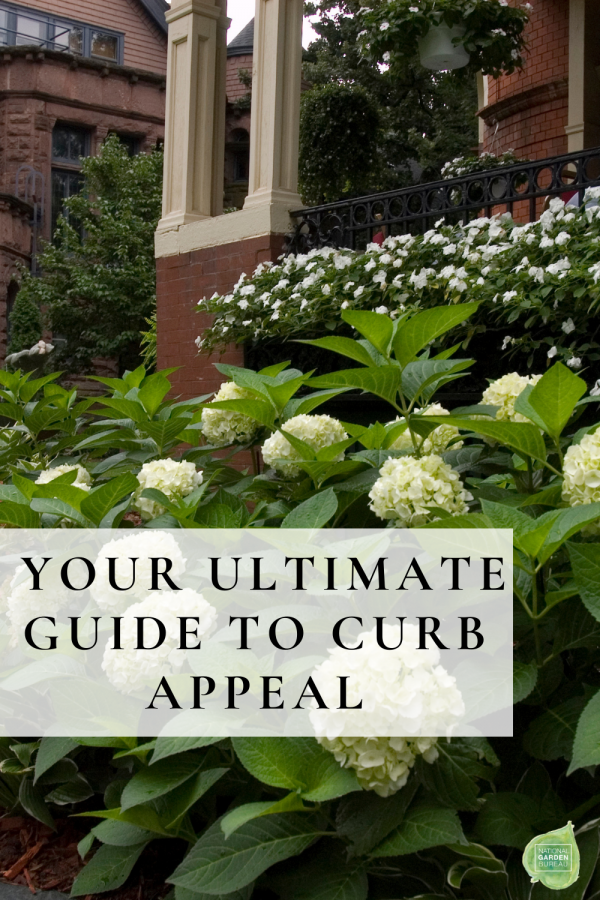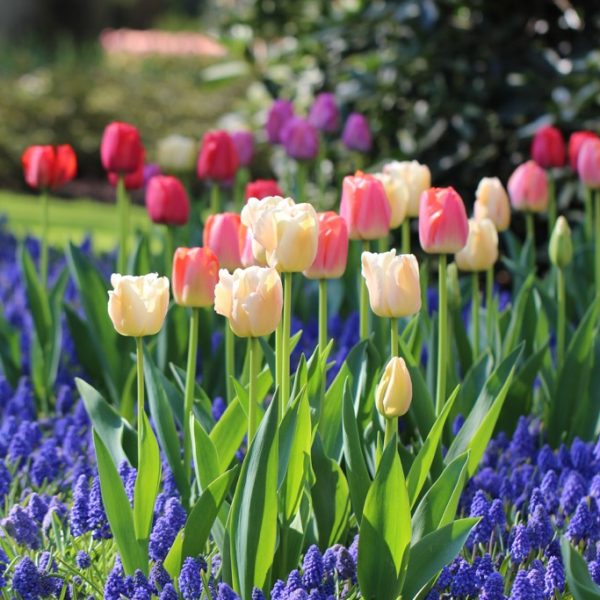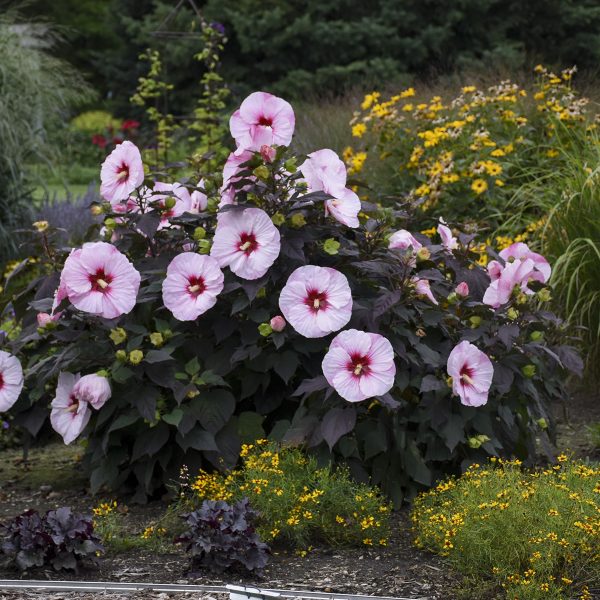Get the Best Front Yard on the Block
Curb appeal: it’s a term bantered about by real estate agents and DIYers. You’ve heard about the importance of curb appeal, and maybe you’ve tuned into TV shows that flipped sad-looking properties into dreamy, darling aspirational homes. But what’s involved with creating curb appeal? We’ll show you how to make your front yard look its best with ideas for designing an alluring, welcoming garden space.
What Exactly Is Curb Appeal?
Curb appeal refers to the first impression of a home from the street. It’s particularly necessary when trying to attract potential homebuyers in a competitive real estate market, but it’s equally important to relish the view of your front garden and home when you pull into your driveway each day. While houses with terrific curb appeal often sell more quickly and for a higher value than those that lack charm, an inviting, attractive front yard and entranceway also welcomes friends and visitors and provides a pretty place to unwind. Plus, if you harbor competitive genes, good curb appeal might win you that coveted “Yard of the Month” award from your neighborhood association!
Why Bother with Curb Appeal?
Homes with high curb appeal tend to sell for an average of seven percent more than similar homes with an uninviting exterior, according to a joint study by the University of Alabama and the University of Texas at Arlington. The study, published in the Journal of Real Estate Finance and Economics, continues to stress the importance of curb appeal, stating that the premium jumps to a 14 percent higher price tag in slower real estate markets. Not only does adding curb appeal make good economic sense, it makes good aesthetic sense, too.
How to Create Curb Appeal
While landscape designers often recommend investing 10 percent of the value of your home into creating a landscape with curb appeal, most homeowners balk at paying tens of thousands of dollars for plants. However, by using some of our tips and tricks, you can create a fabulous front yard without breaking the bank.
10 Tips to Create Curb Appeal
1. Assess Your Style
Before you dig your first bed or purchase a petunia, take a good look at your home. Is it modern or Mediterranean? Does it convey a cottage aesthetic, or is it a classic colonial? Your landscape should serve as an extension of the style of your home. An enticing front landscape complements the house, serving as an inviting space that extends from the curb to the front door. After all, the true purpose of a front yard landscape is to create a welcoming exterior and transition from the street to the entrance of the house.
Your home’s style helps guide the front landscape design. While a cute cottage lends itself to a white picket fence with a colorful tumble of perennials and annuals that welcome friends (as well as pollinators), a more modern home may demand monochromatic, symmetrical topiaries, shrubs, and trees or a singular color for blooms. A landscape filled with pure white flowers looks just as beautiful as one filled with a rainbow of color, depending on the home’s style. Take a good look at your home, consider your personal preferences, and extend your vision into the front garden.
2. Add Good Bones
One of the best times to consider curb appeal starts when the garden is bare. Take a look at your front landscape during bleak winter days. Is it barren, lacking interest and structure? It’s easy to make a front landscape look good during the growing season when it’s filled with amazing annuals or bulbs bursting with color, but front yards should deliver curb appeal all four seasons.
During the winter months, check the bones of your garden. Good “bones” include trees with interesting bark or form, evergreen shrubs with multi-season interest, perennial grasses that provide texture and movement even when dormant, and hardscaping, such as pathways, fences, raised beds, arbors, and gates. Good garden bones work throughout the year to provide great curb appeal, but they really shine in winter when covered in snow. They also add interest on gray days when there’s not a bloom to be found in the garden.
Naturally, you want to install good bones that look lovely all year. Shrubs add superior structure throughout all four garden seasons. “Woe is a garden that doesn’t contain the ever-useful and beautiful shrub!” says, Natalie Carmolli, Advertising, and PR Specialist with Spring Meadow Nursery/Proven Winners® ColorChoice® Shrubs. “Often considered to be the backbone of the garden, the woody structure of shrubs adds definition to your garden spaces and provides year-round interest, [as well as] food and shelter for wildlife. If you’re looking for effortless color that makes your neighbors green with envy, shrubs can be your landscape’s best friend.”
While evergreen shrubs, like boxwoods and hollies, are natural additions to create curb appeal especially in winter, don’t discount deciduous shrubs like hydrangeas, witch hazel, and edgeworthia. Dried hydrangea blooms look lovely throughout fall, then add interest when capped by snow. Winter-blooming edgeworthia and witch hazel add early bits of brightness and fragrance during chilly winter days. (And don’t we all appreciate those sweet flowers in the midst of winter?)
4. Consider Proportions
Planting flowering shrubs not only adds curb appeal, but your vases will benefit, too! Choose multi-purpose shrubs that make great cutting flowers, like hydrangeas, lilacs, or viburnum.
5. Follow the Flow
When creating a front yard landscape, one of the primary objectives is to guide visitors to the front door. That seems obvious, right? But without a path or a natural flow in the front garden, visitors may not know if the front door or side door is the preferred entrance. Obviously, one of the best ways to avoid confusion is to create a defined path, whether it’s made with stepping-stones, bricks, or concrete. Guide the visitor with plants that create “flow” along the path, creating a natural progression through the space. By adding plants along a pathway that leads to the entryway, you’ve created an inviting space where visitors can stop and smell the roses or watch pollinators play. Even a clean, simple planting of foliage, like caladium or ferns, adds interest and guides the visitor to the entrance.
6. Create Color
For a beautiful burst of curb appeal, add flowering bulbs to your landscape. Not only will the lively colors look fantastic, but the first spring blooms also bring delight after gloomy winter days. “Spring flower bulbs are up and blooming long before most annuals and perennials,” says Kathleen LaLiberte, Horticultural Consultant with Longfield Gardens. “For bold, front yard color, plant trumpet daffodils, and Darwin hybrid tulips. Both have large flowers on tall stems and always make a big impact.”
To keep the garden looking tidy as spring bulb foliage fades, pair daffodil and tulip bulbs with perennials like hostas: the broad leaves emerge as the blooms fade, helping to mask dying bulb foliage. Daylilies, phlox, and other summer-flowering perennials also add color to spring bulb beds after they’ve bloomed, providing long-season interest. Stunning summer bulbs add gorgeous color and fragrance to the front garden during hot summer. “Most summer-blooming bulbs are at their best in late summer, when many other plants are starting to fade,” says LaLiberte. “Plan ahead and avoid the slump by including dahlias, lilies, cannas, and gladiolus in your flower beds and containers.”
Use colorful golf tees to mark where you’ve planted bulbs. When you add perennials, annuals, or more bulbs to the bed while the bulbs are dormant, you’ll avoid harming the existing bulbs when you dig.
7. Repeat an accent color



Good garden designers often choose an accent color to repeat throughout a landscape. If your house sports burgundy shutters or trim, for instance, consider adding pops of burgundy throughout your landscape design, like a pretty Japanese maple with burgundy foliage, native sweetshrub with beautiful, fragrant burgundy blooms, loropetalum, Black Diamond® Crapemyrtle with deep burgundy-black foliage, or heuchera with dark reddish-purple leaves. Pick one hue and plant pops of that accent color throughout the landscape. Your front yard will look like you hired a high-end landscape designer!
8. Dress Up Your Porch with Pots
No matter the size of your front yard, creative containers are one of the best ways to boost curb appeal. Whether your house boasts a big, wrap-around porch or a narrow, elegant entryway, container gardens make a gorgeous addition to your home. If you’re using accent color throughout the landscape, choose containers in that hue as another “pop” of color.
“Whether your home is a small cottage or a grand estate, focusing on creating curb appeal is a smart investment in future value,” says Christina Salwitz, owner, and “Horticultural Guidance Counselor” of The Personal Garden Coach. “Adding a dramatic container as a focal point, either in the landscape or near the front entry, is a smart way to stretch your gardening dollars and adds a personal touch that shows your style. Use trees, shrubs, and perennials that you can grow for a season or longer, then add them to your landscape over time to build your plant collection.”
9. Spice Up Your Landscape with a “Wow” Factor
Creating gorgeous curb appeal can involve classic shrubs and flowers, but it’s always best to let your personality shine in the landscape. Choose a favorite piece of garden art as a focal point, or add a spectacular plant that turns heads.
“If you don’t have a hardy hibiscus in your yard, they are definitely worth considering,” says Andrew Jager, Marketing Manager for Walters Gardens. “A mature hardy hibiscus in the landscape can’t be overlooked. Once they get going in summer, they grow more than an inch a day and have massive, tropical-looking flowers that get seven to nine inches wide.” While some hardy hibiscus reach massive sizes, the Summerific® collection from Proven Winners® Perennials was bred to behave in smaller gardens. “Our goal has been to tame the rangy habits of the traditional selections with sturdier, more well-rounded plants,” says Jager. “This often leads to more compact selections that are easier to fit in your average garden. [These] hardy hibiscus bloom earlier and longer, and they have more flowers.”
Finally, Polish Your Garden
Like combing your hair before a photo or brushing the lint off your suit before an interview, you want to make a great impression with your front yard garden. For a perfect, finishing touch, add a layer of mulch to the landscape. Not only does it make the entire garden look tidy and pretty, but mulch also helps preserve moisture in the soil, prevents weeds, and adds organic matter into beds as it decomposes, making your up-keep of the landscape much easier.
Whether you intend to sell your home or plan to stay put for decades, creating curb appeal makes great garden sense. After all, as we spend more time at home, it’s important to create spaces to savor, and by using a few tips to create curb appeal, who knows?
Maybe you’ll find a “Yard of the Month” sign displayed prominently in your garden this summer!
“This post Curb Appeal is provided as an educational/inspirational service of the National Garden Bureau and our members. Please credit and link to National Garden Bureau and author member when using all or parts of this article.”
















